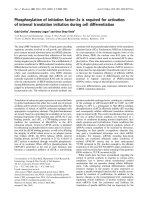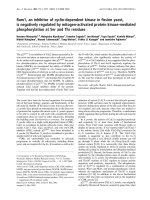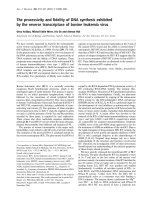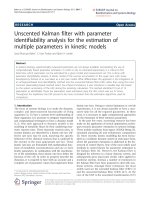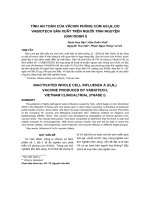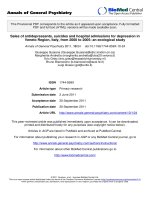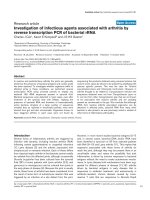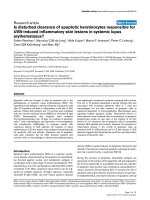Báo cáo y học: " RT-SHIV, an infectious CCR5-tropic chimeric virus suitable for evaluating HIV reverse transcriptase inhibitors in macaque models" ppt
Bạn đang xem bản rút gọn của tài liệu. Xem và tải ngay bản đầy đủ của tài liệu tại đây (328.95 KB, 11 trang )
BioMed Central
Page 1 of 11
(page number not for citation purposes)
AIDS Research and Therapy
Open Access
Research
RT-SHIV, an infectious CCR5-tropic chimeric virus suitable for
evaluating HIV reverse transcriptase inhibitors in macaque models
Yonghou Jiang
1
, Baoping Tian
1
, Mohammed Saifuddin
2
, Michael B Agy
1
,
Peter Emau
1
, J Scott Cairns
3
and Che-Chung Tsai*
1
Address:
1
Washington National Primate Research Center, University of Washington, Box 357330 Health Sciences Building, Seattle, Washington
98195, USA,
2
CONRAD, Eastern Virginia Medical School, Arlington, Virginia 22209, USA and
3
Fifth Opus Consulting, LLC Mercer Island,
Washington 98040, USA
Email: Yonghou Jiang - ; Baoping Tian - ; Mohammed Saifuddin - ;
Michael B Agy - ; Peter Emau - ; J Scott Cairns - ; Che-
Chung Tsai* -
* Corresponding author
Abstract
Background: Non-nucleoside reverse transcriptase inhibitors (NNRTIs) are an important
category of drugs for both chemotherapy and prevention of human immunodeficiency virus type 1
(HIV-1) infection. However, current non-human primate (NHP) models utilizing simian
immunodeficiency virus (SIV) or commonly used chimeric SHIV (SIV expressing HIV-1 envelope)
are inadequate due to the insensitivity to NNRTIs. To develop a NHP model for evaluation of
NNRTI compounds, we characterized a RT-SHIV virus that was assembled by replacing the
SIV
mac239
reverse transcriptase (RT) with that of HIV-1HXB2. Since RT-SHIV exhibited in vitro
characteristics of high infectivity, CCR5-usage, and sensitivity to HIV-1 specific NNRTIs, this virus
was thought to be suitable for mucosal transmission and then was used to carry out a vaginal
transmission study in pigtail macaques (Macaca nemestrina).
Results: RT-SHIV exhibited in vitro characteristics of an infectious CCR5-tropic chimeric virus.
This virus was not only highly sensitive to HIV-1 RT specific NNRTIs; its replication was also
inhibited by a variety of NRTIs and protease inhibitors. For in vivo vaginal transmission studies,
macaques were either pretreated with a single dose of DMPA (depot medroxyprogesterone
acetate) or left untreated before intravaginal inoculation with 500 or 1,000 TCID
50
of RT-SHIV. All
macaques became systemically infected by 2 or 3 weeks post-inoculation exhibiting persistent high
viremia, marked CD4
+
T cell depletion, and antiviral antibody response. DMPA-pretreated
macaques showed a higher mean plasma viral load after the acute infection stage, highly variable
antiviral antibody response, and a higher incidence of AIDS-like disease as compared with macaques
without DMPA pretreatment.
Conclusion: This chimeric RT-SHIV has exhibited productive replication in both macaque and
human PBMCs, predominantly CCR5-coreceptor usage for viral entry, and sensitivity to NNRTIs
as well as other anti-HIV compounds. This study demonstrates rapid systemic infection in
macaques following intravaginal exposure to RT-SHIV. This RT-SHIV/macaque model could be
useful for evaluation of NNRTI-based therapies, microbicides, or other preventive strategies.
Published: 5 November 2009
AIDS Research and Therapy 2009, 6:23 doi:10.1186/1742-6405-6-23
Received: 4 July 2009
Accepted: 5 November 2009
This article is available from: />© 2009 Jiang et al; licensee BioMed Central Ltd.
This is an Open Access article distributed under the terms of the Creative Commons Attribution License ( />),
which permits unrestricted use, distribution, and reproduction in any medium, provided the original work is properly cited.
AIDS Research and Therapy 2009, 6:23 />Page 2 of 11
(page number not for citation purposes)
Background
Heterosexual contact is the predominant route of virus
transmission for the HIV epidemics especially in the
developing countries worldwide, where women are most
vulnerable [1]. The pandemic spread of HIV/AIDS
through sexual contact and the slow progress towards an
effective vaccine have prompted the search for effective
vaginal and rectal microbicides to help mitigate HIV
mucosal transmission [2-10]. Various agents have been
investigated as topical anti-HIV microbicides including
nonnucleoside reverse transcriptase inhibitors (NNRTIs)
[2,3,5,11-23]. For an effective preclinical evaluation of
these agents, validated animal models are urgently
needed. Ideally, the challenge viruses for these models
should mimic HIV mucosal transmission predominantly
using CCR5 coreceptor, express HIV-1 genes such as RT
that are appropriate as therapeutic targets, and induce
rapid and readily detectable systemic infection that
progress to AIDS-like illness.
NNRTI compounds with high binding affinity for RT are
potent inhibitors of HIV-1 replication. However, due to
the specific reactive-site requirements of NNRTI, these
compounds only inhibit the RT of HIV-1, but not SIV or
HIV-2. Thus, while SIV and HIV-2 are well suited to study
lentivirus infection and pathogenesis in Asian macaques,
they cannot be used to evaluate virus control by HIV-1
specific NNRTI compounds. Early attempts to overcome
subtle differences between HIV and SIV while allowing for
productive macaque infections resulted in development
of several chimeric SHIV strains. The first SHIV construc-
tion sought incorporation of HIV-1 env into SIV and was
used to challenge macaques immunized with HIV-1 env-
based candidate vaccines. After that a number of RT-SHIV
strains were constructed to evaluate the activity of HIV-
specific NNRTIs both in vitro and in macaques [24-29].
Consequently, several macaque models were developed
by using different RT-SHIVs [23-26,29-36]. Since most of
these RT-SHIV/macaque models were designed to evalu-
ate NNRTIs as therapies, the preferred infection route was
intravenous injection. However, recently, mucosal trans-
mission of RT-SHIV have been reported by two laborato-
ries [34,35] in which all rhesus macaques had been
pretreated with DMPA (Depo Provera
®
) before intravagi-
nal viral exposure. It is known that prior administration of
DMPA enhances mucosal viral transmission by thinning
of the vaginal epithelium [37] and also possibly by sup-
pression of antiviral immune response [38].
Clearly, a more physiologically relevant RT-SHIV/
macaque model for mucosal transmission will help expe-
dite evaluation of anti-HIV topical microbicides. We have
serially passaged an RT-SHIV virus stock obtained from
Louis Alexander [28] in different cell types including
human and macaque PBMCs before generating a large
virus stock in CEMx174 cells for in vitro and in vivo char-
acterization. The in vitro studies show that the new virus
stock was highly replicative in both human and macaque
cells, predominantly CCR5-tropic and highly sensitive to
NNRTIs. This RT-SHIV stock was then used to infect pig-
tail macaques by intravaginal inoculation. In this report
we have demonstrated an efficient transmission of this
RT-SHIV through single intravaginal exposure in both
DMPA-treated or untreated macaques, and compared the
virus transmission efficiency, levels of plasma viremia,
clinical outcome and antiviral antibody response between
the two groups. Consequently, we have established a suit-
able non-DMPA RT-SHIV model in pigtail macaques for
efficacy evaluation of anti-HIV drugs especially NNRTI-
based topical microbicides.
Results
In vitro replicability of RT-SHIV
As shown in Figure 1A, RT-SHIV replicated rapidly to high
levels in PBMC cultures from both humans (huPBMC)
and macaques (Macaca nemestrina, mnePBMC and M. fas-
cicularis, mfaPBMC). RT-SHIV replication ability in
human CD4
+
Tcell lines is shown in Figure 1B. This virus
replicated efficiently to high levels in MT-4, CEMx174 and
PM1, to low levels in MOLT4CCR5 and poorly in MT-2
cells. The in vitro specificity of CCR5 coreceptor usage by
RT-SHIV is shown in Figure 1C. In vitro replication kinetics
of RT-SHIV, SIV
mac239
and HIV-1
Lai
in CEMx174 cells are
shown in Figure 2. Three viruses exhibited similar replica-
tion kinetics as evidenced by the production of viral core
antigen in the culture supernatants. Together, these results
indicate that RT-SHIV revealed the characteristics of a
highly infectious and rapid replicating CCR5-tropic virus.
Coreceptor usage of RT-SHIV for the entry of target cells
The chemokine receptors CCR5 and CXCR4 are the two
main coreceptors essential for HIV, SHIV and SIV entry. To
determine chemokine receptor use by RT-SHIV, we stud-
ied the ability of five different human CD4
+
T cell lines
known to express one or more coreceptors on the cell sur-
face [MT-2 (CXCR4), MT-4 (CXCR4/other), MOLT4CCR5
(CCR5), PM1 (CCR5), and CEM x174 (CXCR4/CCR5/
other)] to support replication of this virus. As shown in
Figure 1B, the RT-SHIV replicated to a high level in the
CCR5-expressing CEMx174 and PM1 cells, and unexpect-
edly also in MT4 cells that do not express CCR5 but
CXCR4 and possibly other receptors. Interestingly, RT-
SHIV did not replicate well in MOLT4 cells that express
CCR5, and did not grow at all in CXCR4-expressing MT-2
cells. Furthermore, the level of virus replication was
directly correlated with the level of syncytium induction
(SI) in CCR5-expressing CEMx174 and PM1 cells (syncy-
tial data not shown); however, there was no SI in CXCR4-
expressing MT4 cells in spite of high virus replication, and
in contrast, relatively high level of SI activity observed in
AIDS Research and Therapy 2009, 6:23 />Page 3 of 11
(page number not for citation purposes)
MOLT4 cells with a low level of virus replication. There
was no p27 antigen production or SI activity in CXCR4-
expressing MT-2 cells (Figure 1B, data not shown). These
data may suggest that RT-SHIV predominantly use CCR5
coreceptor for target cell entry; nevertheless other
unknown receptors may also be involved for viral entry
and SI activity.
Additional evidence of CCR5 coreceptor usage by RT-
SHIV was shown in Figure 1C where human PBMC cul-
tures were treated with or without coreceptor antagonists
TAK-779 or AMD-3100 before exposing to virus. RT-SHIV
replication was markedly inhibited (≥ 91%) by TAK-779
(CCR5 antagonist, 10 μM) [39] but not by a concentra-
tion of AMD-3100 (CXCR4 antagonist, 1,000 ng/ml) [40]
that strongly inhibited CXCR4-tropic HIV-1
Lai
[41]. Simi-
lar results were also obtained with macaque PBMCs (data
not shown). Together, these data indicate that our RT-
SHIV favors the CCR5 coreceptor mediated entry for rep-
lication in the target cells.
Sensitivity of RT-SHIV and other lentiviruses to NNRTIs
Various concentrations of three different NNRTIs (efa-
virenz, nevirapine and UC781) were used to assess their
inhibitory effects against the replication of HIV-1, RT-
SHIV, SIV
mac239
, SIV
mac251
, and SHIV
89.6P
in PBMC and dif-
ferent human CD4
+
cell lines. As shown in Table 1, the 50
percent effective concentration (EC
50
) of each compound
against specific virus and their 50 percent cytotoxicity con-
centration (CC
50
) (tested in uninfected cell cultures) cal-
culated by linear regression analysis were determined in
specific target cells. The replication of HIV-1 and RT-SHIV
was markedly inhibited by all three NNRTIs, while
SIV
mac239
, SIV
mac251
, and SHIV
89.6P
were either not inhib-
ited at all or inhibited to a much lesser extent. These
results confirmed that RT-SHIV retained the HIV-1 RT
encoding region and remained sensitive to NNRTIs.
Inhibitory effects of other anti-HIV compounds on RT-
SHIV replication
In addition to NNRTIs, we also measured the inhibitory
effects of a variety of other anti-HIV compounds on RT-
SHIV replication in vitro. CEMx174 cells were incubated
with RT-SHIV in the presence or absence of various con-
centrations of each anti-HIV compound. The CC
50
and
EC
50
were determined as described above. The selectivity
index (SI), the ratio of CC
50
to EC
50
was also determined.
As shown in Table 1 and Table 2, RT-SHIV was markedly
inhibited by all three NNRTIs (UC781, efavirenz, and nev-
irapine), and also by a number of NRTIs (AZT and D4T),
and protease inhibitors (PIs: indinavir and saquinavir).
The antiviral effect was less pronounced with 3TC, FTC,
tenofovir, and ritonavir; nevertheless, these in vitro effi-
cacy data indicate that RT-SHIV is sensitive not only to
NNRTIs but also to NRTIs and PIs. Thus, the RT-SHIV/
macaque model could be suitable for efficacy evaluation
of microbicides and a variety of anti-HIV drugs (i.e.,
NNRTIs, NRTIs, or PIs).
Systemic infection after vaginal RT-SHIV transmission in
macaques
To establish mucosal transmission of RT-SHIV, a group of
four pigtail macaques were pretreated with or without
DMPA (depot medroxyprogesterone acetate, Depo
Provera
®
) for 30 days before inoculating with a single dose
of 500 or 1,000 TCID
50
of virus. Regardless of DMPA pre-
treatment or the viral inoculum dose (500 or 1,000
TCID
50
), all macaques became systemically infected
within two weeks of intravaginal inoculation of RT-SHIV
as determined by the presence of both high level viral
In vitro characterization of RT-SHIVFigure 1
In vitro characterization of RT-SHIV. Replication of RT-SHIV in cultures of PBMCs from humans (huPBMC) and macaques
(Macaca nemestrina, mnePBMC; Macaca fascicularis, mfaPBMC) is shown in panel A. The coreceptor tropism of RT-SHIV is
shown in five different human CD4
+
T cell lines in panel B. The specific coreceptor usage by RT-SHIV is shown in panel C
where human PBMC cultures were treated with or without coreceptor antagonist TAK-779 or AMD-3100 before incubating
with RT-SHIV. Relative virus replication levels (core antigen SIV p27) measured in the culture supernatants after 7 days post
incubation, are shown at the left of the panels. Values shown here are representative of three independent experiments.
Control TAK-779 AMD3100
0
20
40
60
80
100
120
p27 antigen (ng/ml)
huPBMC mnePBMC mfaPBMC
0
20
40
60
80
100
120
MT-2 MOLT4CCR5 MT-4 CEMx174 PM-1
0
20
40
60
80
100
120
C
B
A
AIDS Research and Therapy 2009, 6:23 />Page 4 of 11
(page number not for citation purposes)
Table 1: In vitro efficacy of NNRTIs against RT-SHIV and other lentiviruses
NNRTIs CC
50
(μM) EC
50
(μM)
HIV-1* RT-SHIV SIV
mac239
SIV
mac251
SHIV
89.6P
Efavirenz 3~45 < 0.001 0.003 > 5 > 5 > 5
Nevirapine 84~100 0.028 0.06 > 100 > 100 > 100
UC781 51~66 < 0.005 0.003 > 50 > 10 > 20
CC
50
: 50% cytotoxic concentration; EC
50
: 50% effective concentration.
*NNRTIs showed a strong inhibitory activity to both HIV-1
Lai
and HIV-1
BaL
.
RNA in plasma (Figures 3A,B,C) and proviral DNA in
PBMCs (data not shown). Both DMPA-treated and non-
treated macaques showed a peak plasma viremia greater
than 10
6
copies/ml (5 of 8 macaques had a peak viremia
above 10
7
copies/ml) during the acute stage of infection
(week 2-4 post inoculation, pi) (Figure 3). However, the
set point of virus load at post acute stage (week 8-12 pi)
and particularly at the late stage (week 16-20 pi) was sig-
nificantly higher in DMPA-treated macaques than in non-
DMPA macaques (p < 0.05, independent t tests).
Changes of CD4
+
T cell and B cell numbers in RT-SHIV
infected macaques
All RT-SHIV infected macaques showed a significant
CD4
+
T cell depletion in peripheral blood (Figure 4A,B).
The decline of CD4
+
T cells at the acute stage of infection
(week 2-4 pi) was slightly more pronounce in non-DMPA
macaques than the DMPA-treated macaques. As shown in
Figure 4C and 4D, both DMPA-treated and untreated
macaques also showed a sharp decrease of B cells in
peripheral blood during the initial phase of viral infection
(week 2-3 pi). Interestingly, three of four DMPA-treated
macaques showed a gradual decline of B cells until the
end of the study (week 24 pi) but one macaque (04103)
showed a large increase in B cells at week 4 pi and then a
gradual decline until week 24 pi. In contrast, three of four
non-DMPA macaques showed a continuous increase of B
cells until week 24 pi, and one macaque (99151) in this
group maintained a moderately low level B cell during
week 12-24 pi following a slight increase at week 4 pi. The
overall lower B cell numbers in DMPA macaques com-
pared to non-DMPA group imply that DMPA treatment
may have affected the humoral antiviral immune
response.
Antiviral antibody response in RT-SHIV infected macaques
Antiviral antibodies (Abs) were detected in all RT-SHIV
infected macaques at week 4 pi (Figure 5). DMPA-treated
macaques showed a significant variation in their Ab
response. Three macaques (04103, 04093 and 04099)
showed greatly fluctuating levels of Ab while macaque
04107 showed gradual increase in Ab up to week 16 pi
before decreasing at later time points. In contrast, non-
DMPA macaques showed an uniform high level Ab
response which increased gradually until peaked between
week 12-16 pi, and was maintained thereafter except the
macaque A99296 that peaked at week 20 before plateau-
ing.
Clinical features of RT-SHIV infected macaques
The clinical outcomes were more severe in the DMPA-
treated macaques than non-DMPA macaques. Three of
four macaques in DMPA group were euthanized due to
AIDS-like disease (severe CD4
+
T cell depletion, weight
loss, recurrent diarrhea) by week 24 pi. Positive proviral
DNA and recoverable infectious virus was detected in
blood, lymphoid and reproductive tissues collected at
necropsy in these three macaques. The fourth macaque
(04107) with persistent viremia and severe CD4
+
T cell
depletion also showed AIDS-like disease and was eutha-
Replication kinetics of RT-SHIV, SIV, and HIV-1Figure 2
Replication kinetics of RT-SHIV, SIV, and HIV-1.
Human CEMx174 cells were infected with RT-SHIV,
SIV
mac239
and HIV-1
Lai
at doses equivalent to multiplicity of
infection of 0.01. SIV p27 or HIV-1 p24 antigen levels (shown
on the left) were measured in culture supernatants to moni-
tor viral replication. Each time point represents the average
of duplicate cultures and data shown here are the mean of
three independent experiments.
02468
0
1000
2000
3000
4000
5000
p27 or p24 antigen (ng/ml
Days post infection
SIVmac239
RT-SHIV
HIV-1
AIDS Research and Therapy 2009, 6:23 />Page 5 of 11
(page number not for citation purposes)
nized at 42 weeks pi. Blood, spleen and lymphoid tissues
collected at necropsy revealed positive proviral DNA. In
the non-DMPA-treated group, one macaque (03042) was
euthanized at week 14 pi because of clinical complica-
tions with fatty liver, decreased liver function, weight loss,
gastroenterocolitis, hind leg immobility, and frequent
vocalizing. Severe loss of CD4
+
T cells and moderate level
of proviral DNA were detected in peripheral blood,
spleen, and lymphoid tissues of this macaque at euthana-
sia. The severity of disease syndrome of this macaque
(03042) may have been only partially associated with RT-
SHIV infection. The other three macaques in this group
did not develop AIDS-like illness before euthanized after
week 24 pi.
Discussion
The purpose of this study was to thoroughly characterize
an RT-SHIV virus and to determine whether this virus can
be used to evaluate in vivo efficacy of potential HIV-1 pre-
ventive or therapeutic strategies especially NNRTI-based
topical microbicides. We have shown that RT-SHIV repli-
cates efficiently in both human and macaque PBMCs and
Table 2: Inhibition of RT-SHIV replication by antiretroviral compounds
Drugs Category Anti-HIV drugs EC
50
(μM)
CC
50
(μM)
Selectivity index(SI)
NNRTIs Efavirenz 0.002 ± 0.001 35.72 ± 25.45 17860
Nevirapine 0.06 ± 0.01 > 100 > 1667
UC781 0.003 ± 0.002 59.22 ± 6.56 19740
NRTIs ZIdovudine (AZT) 0.01 ± 0.01 > 100 > 10000
Lamivudine (3TC) 0.43 ± 0.13 > 100 > 233
Stavudine (D4T) 0.01 ± 0.01 66.48 ± 34.84 6648
Emtricitabine (FTC) 0.1 ± 0.1 > 100 > 1000
Tenofovir 0.82 ± 0.62 > 100 > 122
PIs Ritonavir 0.1 ± 0.1 63.92 ± 43.03 639
Indinavir 0.008 ± 0.008 > 100 > 12500
Saquinavir 0.004 ± 0.007 62.18 ± 32.75 15545
NNRTIs: Non-nucleoside reverse transcriptase inhibitors; NRTIs: nucleoside RT inhibitors;
PIs: protease inhibitors
EC
50
: Effective concentration of antiretroviral drug inhibited 50% virus replication.
CC
50
: Cytotoxic concentration of antiretroviral drug showed cytotoxic effect in 50% of cells.
SI: selectivity index represents a ratio of CC
50
to EC
50
.
Plasma viral RNA levels in RT-SHIV infected macaquesFigure 3
Plasma viral RNA levels in RT-SHIV infected macaques. Panel A shows viral RNA (copies/ml) from four macaques that
were pretreated with a single 30 mg dose of DMPA (depot medroxyprogesterone acetate, Depo Provera
®
) for 30 days before
intravaginal challenge with 500 or 1000 TCID
50
of RT-SHIV. Panel B shows viral RNA from four macaques that were not pre-
treated with DMPA before virus challenge. Panel C represents the mean viral loads of four RT-SHIV infected macaques in the
DMPA-treated or in the untreated group. In the non-DMPA group, viral RNA data from macaque 03042 were not available
after 14 weeks post infection because this macaque was euthanized. The viral load of each plasma sample collected at various
weeks pi (x-axis) was tested by standard branched chain DNA amplification assay.
0 2 4 6 8 10 12 14 16 18 20
10
2
10
3
10
4
10
5
10
6
10
7
10
8
024681012141618202224
10
2
10
3
10
4
10
5
10
6
10
7
10
8
02468101214161820
10
2
10
3
10
4
10
5
10
6
10
7
10
8
Non-DMPA
DMPA
DMPA
Weeks post infection
03042
99151
04105
A99296
C
B
A
Non-DMPA
Viral RNA (copies/ml)
04093
04099
04103
04107
AIDS Research and Therapy 2009, 6:23 />Page 6 of 11
(page number not for citation purposes)
also in many different human CD4
+
T cell lines. This virus
preferentially utilizes the CCR5 coreceptor for entry into
the target cells. The in vitro efficacy and cytotoxicity evalu-
ation of NNRTIs and other anti-HIV compounds against
RT-SHIV infection were performed by using our virus
stock which was originally derived from Louis Alexander
[28]. As shown in Tables 1 and 2, this RT-SHIV was sensi-
tive not only to three NNRTIs but also to NRTIs and PIs
tested. The in vitro antiviral activity of NNRTIs in this
study was comparable to other studies [19,24] against the
RT-SHIV virus which was originally derived from the same
source [23]. In addition, another RT-SHIV
mne
also showed
a similar sensitivity to NNRTIs [26] as compared to this
study. In short, our RT-SHIV stock is highly sensitive to
not only NNRTIs but also to other anti-HIV compounds
(e.g., NRTIs and PIs) and thus, is suitable for in vitro effi-
cacy evaluation of a wide variety of anti-HIV compounds.
To determine in vivo susceptibility of pigtail macaques we
conducted a vaginal transmission study with RT-SHIV. All
macaques became systemically infected with persistent
high plasma viremia within two weeks after a single intra-
vaginal inoculation of either 500 or 1,000 TCID
50
of virus
regardless of DMPA pretreatment. All infected macaques
show consistent CD4
+
T cell depletion and positive anti-
viral antibody response. There were no discernable differ-
ences in virus load and CD4
+
T cell depletion between
DMPA- and non DMPA-treated macaques especially dur-
Changes of CD4
+
T cell and B cell numbers in RT-SHIV infected macaquesFigure 4
Changes of CD4
+
T cell and B cell numbers in RT-SHIV infected macaques. A group of four macaques were either
pretreated with a single dose of DMPA or untreated for 30 days prior to intravaginal virus challenge. Whole blood samples col-
lected from macaques were analyzed at various weeks post infection (x-axis) for absolute CD4
+
T cells (panel A, DMPA; panel
B, non-DMPA) and B cells (panel C, DMPA; panel D, non-DMPA) numbers that are shown at the y-axis.
024681012141618202224
200
400
600
800
1000
1200
1400
0 2 4 6 8 1012141618202224
0
200
400
600
800
1000
1200
1400
DMPA
Non-DMPA
03042
99151
04105
A99296
B
A
CD4
+
T cells/μl blood
04093
04099
04103
04107
0 2 4 6 8 10 12 14 16 18 20 22 24
0
150
300
450
600
750
900
0 2 4 6 8 10 12 14 16 18 20 22 24
0
50
100
150
200
250
300
Non-DMPA
DMPA
B cells/μl blood
Weeks post infection
04093
04099
04103
04107
DC
03042
99151
04105
A99296
AIDS Research and Therapy 2009, 6:23 />Page 7 of 11
(page number not for citation purposes)
ing the acute phase of infection (weeks 1-4 pi). However,
the average viremic level during the later stage (up to 20
weeks pi) was significantly higher in the DMPA-treated
macaques (Figure 3A). Furthermore, the changes in B cell
numbers, and the antiviral antibody responses were also
significantly different between the two groups (Figures 4
and 5). Following the onset of modest increase during the
acute infection (3-4 weeks pi) the B cell numbers in
DMPA group continue to decrease until 24 weeks pi.
While in contrast, the B cell numbers appear to increase in
the non-DMPA group. Similarly, the antibody response
was highly variable and overall lower in most of the
DMPA macaques compare to the non-DMPA group.
Immunosuppression has been noted previously in
DMPA-treated macaques [38]. These investigators have
also indicated low virus-specific IFN-gamma production
in DMPA-treated macaques in response to SIV Gag. The
immunosuppressive effect of DMPA on antiviral immune
response may at least in part account for the increased
viral burden and the diversity in antibody level seen in
this study and by others [38]. Nevertheless, our findings
with non-DMPA treated macaques indicate that this RT-
SHIV virus is highly infectious and readily transmissible
through vaginal mucosa in pigtail macaques.
Most of the DMPA-treated animals developed AIDS-like
disease compared to non-DMPA macaques. A couple of
other laboratories have also reported intravaginal trans-
mission of RT-SHIV in DMPA-treated rhesus macaques
[34,35]. In these studies the peak plasma viremia levels
were similar to this current study, however, none of the
infected macaques developed AIDS-like illness. These
studies did not test RT-SHIV for mucosal susceptibility in
non-DMPA treated macaques. In any case, regardless of
the higher clinicopathologic severity in DMPA-treated
macaques, the non-DMPA RT-SHIV model could be con-
sidered more relevant for evaluating microbicide or thera-
peutic agents especially since there will be no systemic
effects on immune system as well as no unnatural thin-
ning of vaginal mucosa caused by DMPA. Besides, single
exposure of a moderate 500 or 1,000 TCID
50
dose of our
RT-SHIV resulted in infection of all the exposed animals
without DMPA treatment, and the peak viremia was sim-
ilar to DMPA-treated animals observed in this and also in
the other two studies [34,35]. Furthermore, careful
mucosal infectivity dose titration may determine that
even lower amount of virus could infect 100% pigtail
macaques as shown in another study where a much lower
dose of this virus infected all the intravaginally exposed
cynomolgus macaques without DMPA treatment [36].
Nonhuman primates provide a surrogate animal model
for HIV/AIDS study since they can not be directly infected
by HIV. Moreover, they are also significantly less suscepti-
ble to chimeric SHIV (SIV with HIV-1 envelope); there-
fore, infection of high percentage of macaques through
mucosal exposure with SHIV remains to be a challenge. To
circumvent this low susceptibility issue, two macaque
Antiviral antibody response in RT-SHIV infected macaquesFigure 5
Antiviral antibody response in RT-SHIV infected macaques. A group of four macaques were either pretreated with a
single dose of DMPA (Panel A) or untreated (Panel B) for 30 days prior to intravaginal virus challenge. Serum samples collected
from each macaque at different weeks post infection (x-axis) were tested for anti-SIV antibodies by an enzyme immunoassay.
The OD450 nm value of each serum shown at the y-axis is the mean of two different values.
0 2 4 6 8 10 12 14 16 18 20 22 24
0.0
0.5
1.0
1.5
2.0
2.5
3.0
0 2 4 6 8 10 12 14 16 18 20 22 24
0.0
0.5
1.0
1.5
2.0
2.5
3.0
DMPA
Non-DMPA
03042
99151
04105
A99296
B
A
Antibody (EIA OD450nm)
Weeks post infection
04093
04099
04103
04107
AIDS Research and Therapy 2009, 6:23 />Page 8 of 11
(page number not for citation purposes)
models; single-dose DMPA and repeated low-dose (non-
DMPA) infection models, have been investigated
[11,12,42]. DMPA causes non-physiological thinning of
vaginal epithelia to enhance virus penetration through
mucosa. Also, evidence suggests that DMPA may have glo-
bal effects on immune system as mentioned earlier [38].
On the other hand, repeated low-dose model may achieve
a high rate of macaque infection through large number of
mucosal exposures; however, it is proved to be highly
labor intensive, expensive and technically challenging.
Overall, given the drawbacks of the two existing models,
intravaginal susceptibility of 100% macaques by single
dose of our RT-SHIV without DMPA-treatment (observed
in this study) may prove to be a model of clear advantages
over the both single-dose DMPA and repeated low-dose
(non-DMPA) macaque models.
Conclusion
In vitro studies confirmed that this RT-SHIV stock exhibits
the critical characteristics of high replication capability in
PBMCs from both humans and macaques, and the prefer-
ential use of CCR5-coreceptor for the viral entry into tar-
get cells. In vitro antiviral assays also revealed that RT-
SHIV is sensitive to HIV-specific NNRTIs and other major
classes of anti-HIV drugs. More importantly, in vivo study
demonstrated that this virus is highly infectious and read-
ily transmissible through vaginal mucosa of macaques,
without pretreatment with DMPA (Depo Provera
®
). Thus,
this RT-SHIV macaque model may have advantages over
the existing models and could be suitable for preclinical
efficacy evaluation of NNRTI-based microbicides or
other prevention strategies against sexual transmission of
HIV-1.
Materials and methods
Viruses
The parental chimeric RT-SHIV virus (RT/SHIV/TC)
kindly provided by Louis Alexander [28] was initially
propagated in CEMx174 cells and tested in several in vitro
studies using human lymphoid cell lines and PBMCs. To
increase infectivity, this virus was serially passaged in
CEMx174 cells and PBMCs from both healthy humans
and Asian-origin macaques. Since this RT-SHIV replicates
better in CEMx174 cells than in phytohemagglutinin
(PHA)-stimulated PBMCs (Figure 1A,B), a large stock of
actively propagating viruses (named RT-SHIV) was pre-
pared in CEMx174 cells. The infectivity titer of this virus
stock was also determined in CEMx174 cells
as10
4
TCID
50
/ml. SHIV
89.6P
was originally obtained from
Keith Reimann [43] and propagated in PHA-stimulated
PBMC from naïve pigtail macaques. HIV-1
Lai
, HIV-1
BaL
,
SIV
mac239
and SIV
mac251
were obtained from the NIH AIDS
Research and Reference Reagent Program. SIV strains were
also propagated and titrated in CEMx174 cells.
Cells and reagents
Human cell lines (CEMx174, MT-2, MT-4, PM-1,
MOLT4CCR5) and all anti-HIV compounds (Efavirenz,
Nevirapine, UC781, AZT, 3TC, D4T, FTC, Tenofovir,
Ritonavir, Saquinavir, TAK-779, and AMD-3100) were
obtained through the NIH AIDS Research and Reference
Reagent Program. Cell lines were maintained in complete
HEPES-buffered RPMI-1640 medium containing 10%
heat-inactivated FBS (fetal bovine serum) (GEMINI Bio-
products, Woodland, CA), 2 mM L-glutamine and 50 μg/
ml penicillin/streptomycin (GIBCO, Grand Island, NY).
PBMCs were obtained from healthy donors of humans or
macaques (M. nemestrina and M. fascicularis). All PBMCs
were isolated from EDTA-treated blood of donors by
Ficoll gradient centrifugation and cultured for 48 h in
RPMI medium containing rIL2 (20 ng/ml) and PHA (2.5
μg/ml) at a density of 2×10
6
cells/ml. The stimulated
PBMCs were washed free of PHA and cultured in complete
RPMI1640 medium containing rIL2 (20 ng/ml), 10%
FBS, and 50 μg/ml penicillin/streptomycin.
In vitro characterization of RT-SHIV
To assess virus infectivity, PHA-stimulated PBMCs
(humans or macaques) or CEMx174 cells were incubated
for 4 hours with RT-SHIV at a multiplicity of infection
(moi) of 0.01, washed once, and then cultured for 7-10
days. The infectivity of all other viruses (SIV, SHIV, or
HIV-1) was tested as controls following the same proce-
dure. To determine coreceptor usage, triplicate wells con-
taining PHA-activated human or macaque PBMC (10
6
ml)
were pretreated with or without the CCR5 antagonist TAK-
779 (10 μM) or the CXCR4 antagonist AMD-3100 (1,000
ng/ml) for 2 hours at 37°C incubation before adding to
RT-SHIV. Cells were then incubated with RT-SHIV for
another four hours, washed to remove unattached virus,
and cultured for 7-10 days. Virus replication in cell cul-
tures was monitored by cytopathic effect (syncytium for-
mation)) and by measuring either SIV p27 or HIV-1 p24
antigen in the culture supernatants using ELISA (Zep-
toMetrix Corporation, Buffalo, NY).
In vitro efficacy assays for NNRTIs and other anti-HIV
compounds
To determine in vitro efficacy of NNRTIs or other drugs,
target cells (MT-4, CEMx174 and MT-2) were added into
96-well plates (1 × 10
4
cells/well) in duplicate and treated
with or without various concentrations of drugs for two
hours at 37°C before incubating with different viruses
(HIV-1, SIV and SHIV
89.6P
) for 6-7 days. Virus replication
was monitored by measuring either SIV p27 or HIV-1 p24
antigen in the culture supernatants by ELISA. This proce-
dure was used to determine the 50% effective concentra-
tion (EC
50
) for each drug [44].
AIDS Research and Therapy 2009, 6:23 />Page 9 of 11
(page number not for citation purposes)
Drug cytotoxicity assays
To determine the cytotoxic effects, actively growing target
cells were similarly incubated with increasing concentra-
tion of each drug for 6-7 days without adding the virus
and then monitored the cell viability. Cytotoxicity was
evaluated by the standard MTT [3-(4,5-dimethylthiazol-2-
yl)-2,5-diphenyltetrazolium bromide] assay as described
previously [45]. This assay was used to determine the 50%
cytotoxic concentration (CC
50
) for each drug [44]. All
experiments were run in duplicate.
Macaques and clinical procedures
Eight naïve pigtail macaques (M. nemestrina) were housed
at the Washington National Primate Research Center in
compliance with its Guide for the Care and Use of Laboratory
Animals. All macaques were confirmed to be serologically
negative for simian type D retrovirus, SIV, and simian T-
cell lymphotropic virus (STLV) prior to infection. One
group of four macaques was pretreated with DMPA
(depot medroxyprogesterone acetate, Depo Provera
®
; a
single dose of 30 mg) for 30 days prior to virus challenge
to minimize animal susceptibility variation by synchro-
nizing their reproductive cycles. Another group of four
macaques were not pretreated with DMPA prior to virus
challenge. Two macaques in each group were inoculated
intravaginally with 500 TCID
50
of RT-SHIV; the remaining
two macaques in each group received 1,000 TCID
50
as pre-
viously described [13,14]. Briefly, 0.5 ml of virus prepara-
tion was atraumatically introduced to the vaginal mucosa
using a stainless steel animal feeding tube. All macaques
were kept in a knee-chest position for at least 15 minutes
to maintain exposure of the virus inoculum to the cervi-
covaginal mucosa. To monitor systemic virus infection,
blood samples were collected from each macaque at
weekly during the first month, then every two weeks for
two months and then monthly for next three months pi.
All procedures for animal handlings were performed
under ketamine (10 mg/kg) anesthesia. All macaques
were inspected daily for general health condition and any
signs or symptoms of illness. Other clinical assessments
included periodic blood samples for CBC (complete
blood counts), serum biochemistry tests, and clinical lab-
oratory diagnoses of suspected causes, if indicated.
Lymphocyte subset analysis
To quantify the absolute number of peripheral blood
CD4
+
T cells, CD8
+
T cells and B cells in the infected
macaques, lymphocyte phenotyping was performed on
EDTA blood samples stained with mouse anti-human
monoclonal antibodies that reacted with macaque lym-
phocytes. Lymphocyte subsets were analyzed with a FAC-
SCalibur flow cytometer and Cellquest software (Becton
Dickinson). CD4
+
and CD8
+
T lymphocytes were defined
as CD3
+
CD4
+
and CD3
+
CD8
+
, respectively and B lym-
phocytes as CD3
-
CD20
+
.
Virus isolation from RT-SHIV infected macaques
The frequency of infected cells in blood was estimated by
quantitative coculture of PHA-stimulated PBMC with
uninfected CEMx174 cells. RT-SHIV from infected cells
readily infects CEMx174 cells and induces marked syncy-
tia in the culture. Infection was monitored by microscopic
examination for syncytium formation and by measuring
SIV gag protein in the culture supernatants using SIV p27
antigen capture ELISA (ZeptoMetrix Corp., Buffalo, NY).
Detection of plasma virus RNA
The level of plasma viremia was quantified by the stand-
ard branched chain DNA (bDNA) amplification assay
(Siemens Medical Solutions Diagnostics, Berkeley, CA).
The limit of detection of viral RNA was 125 copies per mil-
liliter of plasma.
Detection of proviral DNA in PBMC
Genomic DNA was extracted from 1 × 10
6
PBMC using the
Qiagen DNA Blood Kit (QIAamp DNA Blood Mini Kit,
Cat # 51106). SIVmac239 gag-specific primers were used
to amplify virus DNA by PCR as described previously
[13,14,46].
Antiviral antibody assay
Viral antibody titer was assayed by the HIV-2 EIA kit (Bio-
Rad Laboratories, Redmond, WA), taking advantage of the
strong cross reactivity of SIV antibodies to HIV-2 antigen.
Plasma samples from all time points were tested for the
presence of RT-SHIV antibodies following manufacturer's
protocol.
Competing interests
The authors declare that they have no competing interests.
Authors' contributions
YJ carried out the experiments, performed data analysis
and wrote the initial draft of the manuscript; BT per-
formed efficacy assays for NNRTIs and other anti-HIV
drugs and data interpretation; MBA helped with data
interpretation and manuscript review; PE helped with lab-
oratory experiments and data analysis. MS and JSC both
supported the study plan for the development of an intra-
vaginal infection model with RT-SHIV, helped with dis-
cussion on the study progress and review of manuscript.
CCT was responsible for the overall experimental design,
implementation of the project, data interpretation and
manuscript writing.
Acknowledgements
We thank the veterinary and animal husbandry staff at the Washington
National Primate Research Center for excellent care of animals. We thank
Dr. Louis Alexander at Yale University for providing the original RT/SHIV/
TC stock and Dr. Kailash Gupta for his consultation on the study plan and
discussion of the study progress. We also thank the NIH AIDS Research
and Reference Reagent Program for providing the human cell lines and
AIDS Research and Therapy 2009, 6:23 />Page 10 of 11
(page number not for citation purposes)
antiretroviral drugs/compounds. This study was supported by NIH-NIAID
contract NO1-AI-15450 and NIH grant RR-00166.
References
1. Cohen MS, Gay C, Kashuba ADM, Blower S, Paxton L: Narrative
Review: Antiretroviral therapy to prevent the sexual trans-
mission of HIV-1. Ann Intern Med 2007, 146:591-601.
2. Klasse PJ, Shattock R, Moore JP: Antiretroviral drug-based
microbicides to prevent HIV-1 sexual transmission. Ann Rev
Med 2008, 59:455-471.
3. Lederman MM, Offord RE, Hartley O: Microbicides and other
topical strategies to prevent vaginal transmission of HIV.
Nature Review Immunology 2006, 6:371-382.
4. Stone A, Jiang S: Microbicides: stopping HIV at the gate. Lancet
2006, 368:431-433.
5. Shattock RJ, Moore JP: Inhibiting sexual transmission of HIV-1
infection. Nat Rev Microbiol 2003, 1:25-34.
6. Trager RS: Microbicides: Raising New Barriers HIV Infection.
Science 2003, 299:39.
7. Turpin JA: Considerations and development of topical micro-
bicides to inhibit the sexual transmission of HIV. Expert Opin
Investig Drugs 2002, 11:1077-1097.
8. Moench TR, Chipato T, Nancy S, Padian NS: Preventing disease by
protecting the cervix: the unexplored promise of internal
vaginal barrier devices. AIDS 2001, 15:1595-1602.
9. McCormack S, Hayes R, Lacey CJ, Johnson AM: Science, medicine,
and the future: Microbicides in HIV prevention. BMJ 2001,
322:410-413.
10. Pauwels R, DeClercq E: Development of vaginal microbicides
for the prevention of heterosexual transmission of HIV. J
Acquir Immune Defic Syndr Hum Retrovirol 1996, 11:211-221.
11. Veazey RS, Klasse PJ, Schader SM, Hu Q, Ketas TJ, Lu M, Marx PA,
Dufour J, Colonno RJ, Shattock RJ, Springer MS, Moore JP: Protec-
tion of macaques from vaginal SHIV challenge by vaginally
delivered inhibitors of virus-cell fusion.
Nature 2005,
438:99-102.
12. Lederman MM, Veazey RS, Offord R, Mosier DE, Dufour J, Mefford
M, Piatak M Jr, Lifson JD, Salkowitz JR, Rodriguez B, Blauvelt A, Hart-
ley O: Prevention of vaginal SHIV transmission in rhesus
macaques through inhibition of CCR5. Science 2004,
306:485-487.
13. Tsai C-C, Emau P, Jiang YH, Agy MB, Shattock RJ, Schmidt A, Morton
WR, Gustafson KR, Boyd MR: Cyanovirin-N inhibits AIDS virus
infections in vaginal transmission models. AIDS Res Hum Retro-
viruses 2004, 20:11-18.
14. Jiang YH, Emau P, Cairns JS, Flanary L, Morton WR, McCarthy TD,
Tsai C-C: SPL7013 gel as a topical microbicide for prevention
of vaginal transmission of SHIV89.6P in macaques. AIDS Res
Hum Retroviruses 2005, 21:207-213.
15. D'Cruz OJ, Uckun FM: Dawn of non-nucleoside inhibitor-based
anti-HIV microbicides. J Antimicrob Chemother 2006, 57:411-423.
16. Patton DL, Sweeney YT, Balkus JE, Rohan LC, Moncla BJ, Parniak MA,
Hillier SL: Preclinical safety assessments of UC781 anti-
human immunodeficiency virus topical microbicide formula-
tions. Antimicrob Agents Chemother 2007, 51:1608-1615.
17. Pani A, Musiu C, Loi AG, Mai A, Loddo R, La Colla P, Marongiu ME:
DABOs as candidates to prevent mucosal HIV transmission.
Antivir Chem Chemother 2001, 12:51-59.
18. Barnard J, Borkow G, Parniak MA: The thiocarboxanilide nonnu-
cleoside UC781 is a tight-binding inhibitor of HIV-1 reverse
transcriptase. Biochemistry 1997, 36:7786-7792.
19. Balzarini J, Naesens L, Verbeken E, Laga M, Van Damme L, Parniak M,
Van Mellaert L, Anne J, De Clercq E: Preclinical studies on thio-
carboxanilide UC-781 as a virucidal agent. AIDS 1998,
12:1129-1138.
20. Zussman A, Lara L, Lara HH, Bentwich Z, Borkow G: Blocking of
cell-free and cell-associated HIV-1 transmission through
human cervix organ culture with UC781. AIDS 2003,
17:653-661.
21. Fletcher P, Kiselyeva Y, Wallace G, Romano J, Griffin G, Margolis L,
Shattock R: The nonnucleoside reverse transcriptase inhibitor
UC-781 inhibits human immunodeficiency virus type 1 infec-
tion of human cervical tissue and dissemination by migratory
cells. J Virol 2005, 79:11179-11186.
22. Van Herrewege Y, Michiels J, Van Roey J, Fransen K, Kestens L, Bal-
zarini J, Lewi P, Vanham G, Janssen P: In vitro evaluation of non-
nucleoside reverse transcriptase inhibitors UC-781 and
TMC120-R147681 as human immunodeficiency virus micro-
bicides. Antimicrob Agents Chemother 2004, 48:337-339.
23. Uberla K, Stahl-Hennig C, Bottiger D, Matz-Rensing K, Kaup FJ, Li J,
Haseltine WA, Fleckenstein B, Hunsmann G, Oberg B, Joseph
Sodroski: Animal model for the therapy of acquired immuno-
deficiency syndrome with reverse transcriptase inhibitors.
Proc Natl Acad Sci USA 1995, 2:8210-8214.
24. Balzarini J, DeClercq E, Uberla K: SIV/HIV-1 hybrid virus express-
ing the reverse transcriptase gene of HIV-1 remains sensitive
to HIV-1 specific reverse transcriptase inhibitors after pas-
sage in rhesus macaques. J Acquir Immune Defic Syndr Hum Retro-
virol 1997, 15:1-4.
25. Zuber B, Bottiger D, Benthin R, ten Haaft P, Heeney J, Wahren B,
Oberg B: An in vivo model for HIV resistance development.
AIDS Res Hum Retroviruses 2001, 17:631-635.
26. Ambrose Z, Boltz V, Palmer S, Coffin JM, Hughes SH, Kewalramani
VN: In vitro characterization of a simian immunodeficiency
virus-human immunodeficiency virus (HIV) chimera
expressing HIV type 1 reverse transcriptase to study antivi-
ral resistance in pigtail macaques. J Virol 2004, 78:13553-13561.
27. Akiyama H, Ido E, Akahata W, Kuwata T, Miura T, Hayami M: Con-
struction and in vivo infection of a new simian/human immu-
nodeficiency virus chimera containing the reverse
transcriptase gene and the 3' half of the genomic region of
human immunodeficiency virus type 1. J Gen Virol 2003,
84:1663-1669.
28. Soderberg K, Denekamp L, Nikiforow S, Sautter K, Desrosiers RC,
Alexander LA: Nucleotide substitution in the tRNA(Lys)
primer binding site dramatically increases replication of
recombinant simian immunodeficiency virus containing a
human immunodeficiency virus type 1 reverse transcriptase.
J Virol 2002, 76:5803-5806.
29. Ambrose Z, Palmer S, Boltz VF, Kearney M, Larsen K, Polacino P,
Flanary L, Oswald K, Piatak M Jr, Smedley J, Shao W, Bischofberger
N, Maldarelli F, Kimata JT, Mellors JW, Hu SL, Coffin JM, Lifson JD,
Kewalramani VN: Suppression of Viremia and Evolution of
HIV-1 Drug Resistance in a Macaque Model for Antiretrovi-
ral Therapy. J Virol
2007, 81:12145-12155.
30. Mori K, Yasutomi Y, Sawada S, Villinger F, Sugama K, Rosenwith B,
Heeney JL, Uberla K, Yamazaki S, Ansari AA, Rubsamen-Waigmann
H: Suppression of acute viremia by short-term postexposure
prophylaxis of simian/human immunodeficiency virus SHIV-
RT-infected monkeys with a novel reverse transcriptase
inhibitor (GW420867) allows for development of potent
antiviral immune responses resulting in efficient contain-
ment of infection. J Virol 2000, 74:5747-5753.
31. North TW, Van Rompay KK, Higgins J, Matthews TB, Wadford DA,
Pedersen NC, Schinazi RF: Suppression of virus load by highly
active antiretroviral therapy in rhesus macaques infected
with a recombinant simian immunodeficiency virus contain-
ing reverse transcriptase from human immunodeficiency
virus type 1. J Virol 2005, 79:7349-7354.
32. Hofman MJ, Higgins J, Matthews TB, Pedersen NC, Tan C, Schinazi RF,
North TW: Efavirenz therapy in rhesus macaques infected
with a chimera of simian immunodeficiency virus containing
reverse transcriptase from human immunodeficiency virus
type 1. Antimicrob Agents Chemother 2004, 48:3483-3490.
33. Rosenwirth B, ten Haaft P, Bogers WM, Nieuwenhuis IG, Niphuis H,
Kuhn EM, Bischofberger N, Heeney JL, Uberla K: Antiretroviral
therapy during primary immunodeficiency virus infection
can induce persistent suppression of virus load and protec-
tion from heterologous challenge in rhesus macaques. J Virol
2000, 74:1704-1711.
34. Turville SG, Aravantinou M, Miller T, Kenney J, Teitelbaum A, Hu L,
Chudolij A, Zydowsky TM, Piatak M Jr, Bess JW Jr, Lifson JD, Blan-
chard J, Gettie A, Robbiani M: Efficacy of Carraguard-based
microbicides in vivo despite variable in vitro activity. PLoS
ONE 2008, 3:1-14.
35. Pal R, Nuttall J, Galmin L, Weiss D, Chung HK, Romano J: Charac-
terization of vaginal transmission of a simian human immu-
nodeficiency virus (SHIV) encoding the reverse
transcriptase gene from HIV-1 in Chinese rhesus macaques.
Virology 2009, 386:102-108.
Publish with BioMed Central and every
scientist can read your work free of charge
"BioMed Central will be the most significant development for
disseminating the results of biomedical research in our lifetime."
Sir Paul Nurse, Cancer Research UK
Your research papers will be:
available free of charge to the entire biomedical community
peer reviewed and published immediately upon acceptance
cited in PubMed and archived on PubMed Central
yours — you keep the copyright
Submit your manuscript here:
/>BioMedcentral
AIDS Research and Therapy 2009, 6:23 />Page 11 of 11
(page number not for citation purposes)
36. Jiang y, Tian B, Agy MB, Saifuddin M, Tsai C-C: Macaca fascicularis
are highly susceptible to an RT-SHIV following intravaginal
inoculation: a new model for microbicide evaluation. J Med
Primatol 2009, 38(Suppl.1):39-46.
37. Marx PA, Spira AI, Gettie A, Dailey PJ, Veazey RS, Lackner AA,
Mahoney CJ, Miller CJ, Claypool LE, Ho DD, Alexander NJ: Proges-
terone implants enhance SIV vaginal transmission and early
virus load. Nat Med 1996, 2:1084-1089.
38. Trunova N, Tsai L, Tung S, Schneider E, Harouse J, Gettie A, Simon
V, Blanchard J, Cheng-Mayer C: Progestin-based contraceptive
suppresses cellular immune responses in SHIV-infected rhe-
sus macaques. Virology 2006, 352:169-177.
39. Dragic T, Trkola A, Thompson DA, Cormier EG, Kajumo FA, Max-
well E, Lin SW, Ying W, Smith SO, Sakmar TP, Moore JP: A binding
pocket for a small molecule inhibitor of HIV-1 entry within
the transmembrane helices of CCR5. Proc Natl Acad Sci USA
2000, 97:5639-5644.
40. Hendrix CW, Flexner C, MacFarland RT, Giandomenico C, Fuchs EJ,
Redpath E, Bridger G, Henson GW: Pharmacokinetics and safety
of AMD- a novel antagonist of the CXCR-4 chemokine
receptor, in human volunteers. Antimicrob Agents Chemother
3100, 44:1667-1673.
41. Klasse PJ, Rosenkilde MM, Signoret N, Pelchen-Matthews A, Schwartz
TW, Marsh M: CD4-Chemokine Receptor Hybrids in Human
Immunodeficiency Virus Type 1 Infection. J Virol 1999,
73:7453-7466.
42. Tsai L, Trunova N, Gettie A, Mohri H, Bohm R, Saifuddin M, Cheng-
Mayer C: Efficient repeated low-dose intravaginal infection
with X4 and R5 SHIVs in rhesus macaque: implications for
HIV-1 transmission in humans. Virology 2007, 362:207-216.
43. Reimann KA, Li JT, Veazey R, Halloran M, Park IW, Karlsson GB,
Sodroski J, Letvin NL: A chimeric simian/human immunodefi-
ciency virus expressing a primary patient human immunode-
ficiency virus type 1 isolate env causes an AIDS-like disease
after in vivo passage in rhesus monkeys. J Virol 1996,
70:6922-6928.
44. Emau P, Tian B, O"keefe BR, Mori T, MacMahon JB, Palmer KE, Jiang
Y, Bekele G, Tsai CC: Griffithsin, a potent HIV entry inhibitor,
is an excellent candidate for anti-HIV microbicide. J Med Pri-
matol 2007, 36:244-253.
45. Mosmann T: Rapid colorimetric assay for cellular growth and
survival: Application to proliferation and cytotoxicity assays.
J Immunol Methods 1983, 65:55-63.
46. Watson A, Ranchalis J, Travis B, McClure J, Sutton W, Johnson PR, Hu
SL, Haigwood NL: Plasma viremia in macaques infected with
simian immunodeficiency virus: plasma viral load early in
infection predicts survival. J Virol 1997, 71:284-290.
